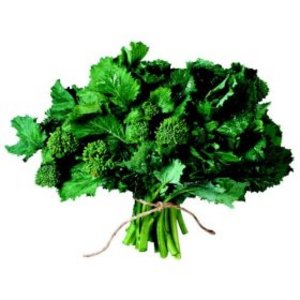The produce section of the supermarket is an ever-growing entity, as demand for new and unique fruits and vegetables continues to increase. Many supermarkets have seen an influx of exotic or previously unheard fruits and vegetables as the popularity of such items rises with the changing mood of the food market, and the advent of entertaining cooking shows that have introduced consumers to many new ingredients and foods.
One such vegetable that now appears in several incarnations is broccoli. No longer content with the simple green stalks and tiny budding florets of this versatile vegetable, consumers are now eagerly snatching up broccoli hybrids and other vegetables that bear the broccoli name but actually have little to do with broccoli itself, such as broccoli rabe.
Broccoli Rabe
The cabbage relative goes by many names, including broccoli raab, rapini and broccoletto, but it is most commonly referred to as broccoli rabe, and can now be found in most supermarkets and in many restaurants across the country. Often found in Southern Italy cuisine for quite some time, its popularity has seemingly migrated to the United States nearly overnight.
Broccoli Rabe appears as a leafy vegetable similar to kale or cabbage, with small broccoli-like florets mixed within the mass of leaves, all of which sit atop stems which are typically discarded, unlike broccoli stems, which are usually never discarded before consumption.
Broccoli Rabe can tend to be quite bitter, and is usually blanched in boiling water before additional preparation to help remove the some of the bitterness. An increasingly common way to serve broccoli rabe after fist blanching it is to then saute it with garlic and olive oil and some red pepper flakes. I also sometimes use white cooking wine and mirin or sake for additional subtle flavors. Many restaurants have taken to serving it with pasta dishes.
Broccoli Rabe is rich with phytochemicals that help fight against cancer, and also contains great amounts of Vitamin C, A, K and potassium.
Broccolini
Broccolini is a hybrid of broccoli, appearing as small broccoli florets sitting atop tall, thin stems. Broccolini is a cross between broccoli and Chinese kale, but is somewhat similar in appearance to asparagus, and is often bundled the same way.
Broccolini can be cooked and consumed any number of versatile and flavorful ways, much like broccoli, and is also rich in many vitamins, including A, C, calcium, potassium and iron. Like broccoli, the broccolini stems can also be consumed, and so chefs often utilize broccolini in place of broccoli to make a more charming presentation on the dinner plate.
Broccoflower
Not as common in the supermarket as broccoli rabe or broccolini, broccoflower appears as a cross of broccoli and cauliflower. At first glance, it would appear that someone has dyed a head of cauliflower green. There are actually two classifications of broccoflower, and neither one is a hybrid. In fact, the exact origins of both have yet to be actually determined, as well as which family the vegetable should belong to; broccoli or cauliflower? Oddly enough, broccoflower will turn white if not harvested, and will appear nearly identical to cauliflower, except under close inspection.
Nonetheless, broccoflower can be cooked in a large variety of ways, much like it broccoli or cauliflower counterparts, and is a rich source of Vitamin C.
Broccoflower can often be confused with brocciflower, which is in fact a true hybrid of broccoli and cauliflower. Brocciflower is more easily distinguishable from broccoflower, as the head of the vegetable appears to be a green cauliflower with outreaching sprouts of broccoli-like florets.





